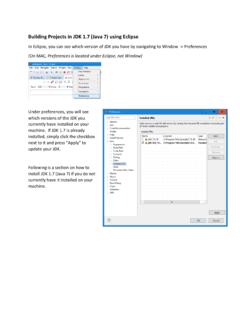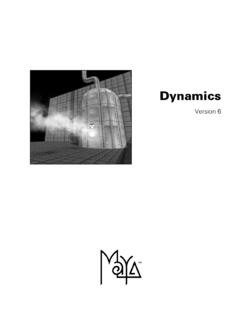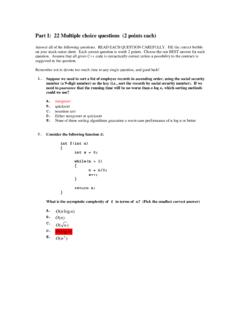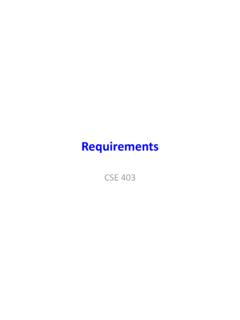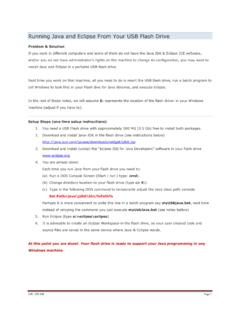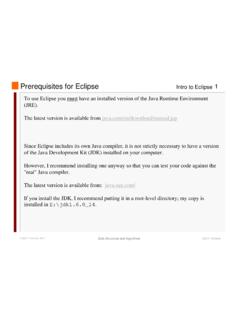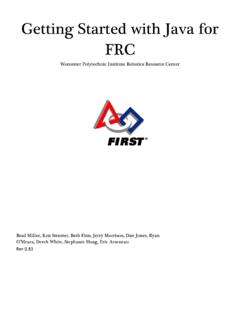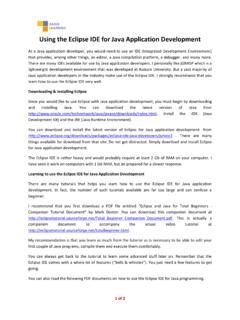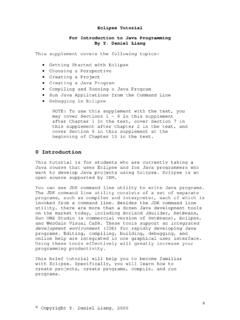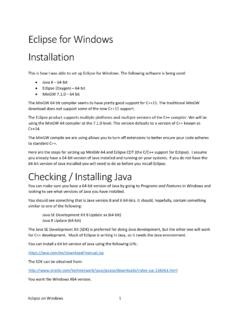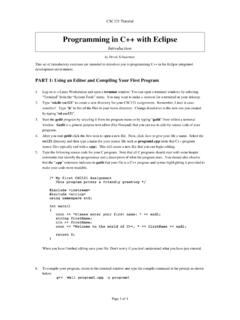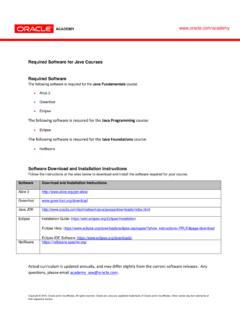Transcription of Java Graphics & GUIs (and Swing/AWT libraries)
1 java Graphics & GUIs(and Swing/AWT libraries )CSE 331 Software Design & ImplementationSlides contain contributions from: M. Ernst, M. Hotan, R. Mercer, D. Notkin, H. Perkins, S. Regis, M. Stepp;Oracle docs & tutorial, Horstmann, Wikipedia, 21 Why study GUIs? Learn about event-driven programming techniques Practice learning and using a large, complex API A chance to see how it is designed and learn from it: design patterns: model-view separation,callbacks, listeners, inheritance vs. delegation refactoring vs. reimplementing an ailing API Because GUIs are neat! Caution: There is way more here than you can memorize.
2 Part of learning a large API is "letting go." First, learn the fundamental concepts and general ideas. Then, look things up as you need them Don t get bogged down implementing eye candyReferencesToday: java Graphics and Swing/AWT class librariesOnly an introduction! Also see Sun/Oracle java Extra slides, on class website Core Javavol. I by Horstmann & Cornell If you have another favorite, use itNext lecture:Event8driven programming and user interaction3 OutlineOrganization of the Swing/AWT libraryGraphics and drawingRepaint callbacks, layout managers, user eventsBuilding GUI applicationsMVC, user events, updates, &c4 java GUI libraries swing : the main java GUI library Benefits: Features; cross-platform compatibility.
3 OO design Paints GUI controls itself pixel-by-pixel Does not delegate to OS s window system Abstract Windowing Toolkit(AWT): Sun's initial GUI library Maps java code to each operating system's real GUI system Problems:Limited to lowest common denominator (limited set of UI widgets); clunky to use. Advice: Use swing . You occasionally have to use AWT ( swing is built on top of AWT). Beware: it s easy to get them mixed terminologywindow: A first8class citizen of the graphical desktopAlso called a top-level containerExamples: frame, dialog box, appletcomponent: A GUI widget that resides in a windowAlso called controlsin many other languagesExamples: button, text box, labelcontainer: A component that hosts (holds) componentsExamples: panel, box6 ComponentsComponent & container classes8 ComponentContainerJcomponentJpanelJFileC hooserTons of JcomponentsVarious AWT containersLots of AWT componentsEvery GUI8related class descends from Component Atomic components.
4 Labels, text fields, buttons, check boxes, icons, menu items2 Containerscan hold nested subcomponentsSwing/AWT inheritance hierarchyComponent (AWT)WindowFrameJFrame( swing )JDialogCont ainerJcomponent( swing )JButton JColorChooser JFileChooserJComboBox JLabel JListJMenuBar JOptionPane JPanelJPopupMenu JProgressBar JScrollbarJScrollPane JSlider JSpinnerJSplitPane JTabbedPane JTableJToolbar JTree JTextAreaJTextField ..9 Component fields (actually properties)Each has a get(or is) accessor and a : getColor, setFont, isVisible, 2namedescriptionbackgroundbackground color behind componentborderborder line around componentenabledwhether it can be interacted withfocusablewhether key text can be typed on itfontfont used for text in componentforegroundforeground color of componentheight, widthcomponent's current size in pixelsvisiblewhether component can be seentooltip texttext shown when hovering mousesize, minimum / maximum / preferred sizevarious sizes, size limits, or desired sizes that the component may takeTypes of containers Top8level containers.
5 JFrame, JDialog, 2 Often correspond to OS windows Can be used by themselves, but usually as a host for other components Live at top of UI hierarchy, not nested in anything else Mid8level containers: panels, scroll panes, tool bars Sometimes contain other containers, sometimes not JPanel is a general8purpose component for drawing or hosting other UI elements (buttons, etc.) Specialized containers: menus, list boxes, 2 Technically, all J8components are containers11 JFrame top8level windowGraphical window on the screenTypically holds (hosts) other componentsCommon methods:JFrame(Stringtitle) constructor, title optionalsetSize(intwidth, intheight) set sizeadd(Componentc) add component to windowsetVisible(booleanv) make window visible or not.
6 Don t forget this! JFrame public void setDefaultCloseOperation(int op)Makes the frame perform the given action when it closes. Common value passed: If not set, the program will never exit even if the frame is closed. public void setSize(int width, int height)Gives the frame a fixed size in pixels. public void pack()Resizes the frame to fit the components inside it a general8purpose containerCommonly used as a place for Graphics , or to hold a collection of button, labels, to be added to a window or other (new Jpanel(..))JPanels can be nested to any depthMany methods/fields in common with JFrame(since both inherit from Component)Advice: can t find a method/field?
7 Check the superclass(es)Some new methods. Particularly useful:setPreferredSize(Dimension d)15 Containers and layoutWhat if we add several components to a container?How are they positioned relative to each other?Answer: each container has a layout managersKinds: FlowLayout(left to right, top to bottom) default for JPanel BorderLayout( center , north , south , east , west ) default for JFrame GridLayout(regular 28D grid) (some are incredibly complex) The first two should be good enough for components in a container; add the container to a frame. container: An object that stores components and governs their positions, sizes, and resizing ()Once all the components are added to their containers, do this to make the window visiblepack();setVisible(true).
8 Pack()figures out the sizes of all components and calls the layout manager to set locations in the container (recursively as needed)If your window doesn t look right, you may have forgotten pack() and positioningHow does the programmer specify where each component appears, how big each component should be, and what the component should do if the window is resized / moved / maximized / Absolute positioning(C++, C#, others):Programmer specifies exact pixel coordinates of every component. "Put this button at (x=15, y=75) and make it 70x31 px in size." Layout managers( java ):Objects that decide where to position each component based on some general rules or criteria.
9 "Put these four buttons into a 2x2 grid and put these text boxes in a horizontal flow in the south part of the frame."JFrame as containerA JFrameis a container. Containers have these methods: public void add(Component comp)public void add(Component comp, Object info)Adds a component to the container, possibly giving extra information about where to place it. public void remove(Component comp) public void setLayout(LayoutManager mgr)Uses the given layout manager to position components. public void validate()Refreshes the layout (if it changes after the container is onscreen).Preferred sizes swing component objects each have a certain size they would "like" to be: Just large enough to fit their contents (text, icons, etc.)
10 This is called the preferred sizeof the component. Some types of layout managers ( FlowLayout) choose to size the components inside them to the preferred size. Others ( BorderLayout, GridLayout) disregard the preferred size and use some other scheme to size the at preferred size:Not preferred size:FlowLayoutpublic FlowLayout() treats container as a left-to-right, top-to-bottom "paragraph". Components are given preferred size, horizontally and vertically. Components are positioned in the order added. If too long, components wrap around to the next (new FlowLayout()); (new JButton("Button 1")); The default layout for containers other than JFrame(seen later).
